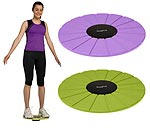Wobble Boards & Balance

After an injury, neuromuscular retraining is an important component
Wobble boards increase strength, flexibility, balance, and co-ordination of the ankle joint after an injury.
Football, soccer, hockey, gymnastics, basketball, cricket, surfing, baseball, athletics, skiing, rugby and other sports all have certain actions that required enhanced co-ordination and strength around the ankle joint. Having this strength not only prevents injury, but gives the player an advantage over his competition.
Wobble boards increase strength, flexibility, balance, and co-ordination of the ankle joint after an injury.
Football, soccer, hockey, gymnastics, basketball, cricket, surfing, baseball, athletics, skiing, rugby and other sports all have certain actions that required enhanced co-ordination and strength around the ankle joint. Having this strength not only prevents injury, but gives the player an advantage over his competition.
Proprioception - the key to balance!
This means the ability of different pars of the body to present a picture to the brain of that parts position relative to both the rest of the body and the ground.
Impulses from all parts of the body present a picture to the brain to which it responds. Following injury these impulses may be disrupted and during healing gradually recover. An essential part of any rehabilitation regime should be the re-education of this proprioceptive mechanism. Ankle injuries in particular affect the proprioception mechanism. If a player attempt to balance on an injured ankle, particularly with his eyes closed, soon after recovery is apparently complete, it will often be noted that his balance is affected, i.e, propriception has been impaired. A player running with their eyes on the ball would therefore have an impaired picture of his foot's positioning relative to the ground. A useful method of re-educating the proprioceptive mechanism of the ankle joint is the use of balance exercises. Activities such as running in water, running backwards, hoping, skipping, with eyes open and closed also assist. In all cases, after injury, the ankles should have protective taping applied to it. |
Wobble Board Instructions
1. Place board on firm surface near wall.
2. Remove shoes and socks 3. Balance without the board edges touching the ground roll the edge of the board on the ground in a continuous circular motion. Rehab for injured ankle The object is to maintain balance on the board, subject to limits of pain. Exercise for 10minutes twice daily until coordination and full range of movement is regained. > Ankle Pain and Ankle Sprains Ankle exercises Players should practice on the board at all training sessions until a skill level is reached where two players can maintain balance and throw a ball to each other. Advanced exercises Maintain balance with 2 feet on the wobble board and eyes closed, then 1 foot on the wobble board with eyes open, and finally, 1 foot ballancing on the wobble board with eyes closed. *Caution is always advised with these sorts of activities and should not be performed by people with neuropathy such as diabetics. |



